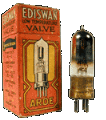How To Series - Transformers - Power & Audio
|
Peter Lankshear, Invercargill, New Zealand. photos coming soon...
[
Safety
|
Basics
|
Transformers
|
Speakers
|
Coils IF & RF
|
Capacitors
|
Resistors
& Pots |
Valves
]
 Power Transformers
Power Transformers
With the chassis out of the cabinet life will be more pleasant if
the worst of the dust, dirt, grime is removed. One effective method is
to use a 1" paint brush and a vacuum cleaner. Note if there is a puddle
of wax or pitch on the floor of the cabinet under the power transformer,
indicating possible problems. Power transformers are generally the most
expensive individual components and are rather vulnerable. The viability
of an overhaul could well depend on the condition of this component.
Transformer failure was often the reason for a receiver's final
retirement and a rewind, if you can get one, can be expensive, so
obviously a check early in the assessment of an overhaul is sensible. Of
course, if a replacement is available there is no problem, but the cost
of a rewind or a new transformer has to be weighed against the final
value of a receiver.
If the windings are visible, look closely for blackened insulation or
excessively melted wax.. Burnt out transformers have a very distinctive
smell, but this may have disappeared. If there are shrouds or covers,
wax running down the leads may be the only sign of trouble. About the
simplest way of checking a power transformer is the 'suck it and see'
system with a few refinements. This entails removing loads from the
windings, energising the primary and checking for overheating .
IMPORTANT - SAFETY FIRST
When dealing with mains-connected equipment safety is of paramount
importance. Check and double check connections and then operate with one
hand in your pocket. If at all possible use an isolating transformer.
First check the condition of the mains lead and plug. If any cracking of
insulation, bare spots or general deterioration is evident, renew them.
American sets often used mains cords with only cotton insulation. These
should be replaced. Inspect the mains plug for wrong connections. If the
earth lead is connected wrongly the chassis could become lethal. With
your test meter set to the highest resistance range, check for any
leakage between the live leads and the chassis. If there is then look
for faulty bypass capacitors between the mains leads and chassis. These
were common on American receivers. There could be a faulty on/off switch
causing leakage, or, if storage has been in a damp situation, there
could be moisture in the transformer. If moisture is suspected direct a
blower heater on to the transformer for a few hours to dry it out.
If the leakage test is OK, check the resistance of the primary winding.
It should lie between about 10 ohms for a very large receiver to perhaps
100 ohms for a very small one. If there is voltage selector check that
it is set at 220-240 v. Beware the receiver with a 2-prong U.S. mains
connector as it may be a ll0-volt model requiring a step-down
transformer.
Having got this far it is time to try the transformer out. Pull out all
the valves but leave a good pilot lamp in its socket. Inspect the
rectifier socket and its associated wiring for arcing or defective
insulation. If all seems OK then, after checking safety aspects, switch
on the mains. The pilot light should light up but there should be no
signs of distress, smoke or loud noises. Leave the power on for Ĺ an
hour or so. Then if the transformer is not more than slightly warm it
can be assumed that it is OK. Finally check that the HT winding is
intact. With the power off the easiest way is to test for continuity
between the rectifier socket anode connections; the reading is normally
a few hundred ohms.
If the transformer appears to be original you have no problems. But if,
as is often the case, it has been replaced at some time there are some
traps to beware of. There is a wide range of voltages for HT windings
and it could be that the wrong replacement has been fitted. The service
data may be of help but many manufacturers were a bit coy when it came
to publishing the figures. It is possible to calculate back from the HT
line roughly what the transformer voltage should be, but for now a few
indications will suffice.
For the average 6-valve radio with a 2500 ohm speaker field the unloaded
transformer HT should be between 350-400 V; for a 1500 ohm field,
320-350V and for a 1000 ohm field 280-320 volts. Resistor filter systems
should be similar in their requirements, but if the set has a filter
choke only the voltage may be as low as 250-280 volts. Note that these
are ballpark figures for average receivers and are given in lieu of
manufacturers' specifications There may be some doubts about the
ratings. The physical size will give an idea of the wattage rating of
the transformer and the best recommendation I can give is to look at
similar types of receivers to get an idea of the likely size needed or a
replacement. Provided it will fit, an oversized transformer will be
satisfactory but an undersized one will overheat.
Assuming that the power transformer situation is satisfactory and the
general condition the rest of the receiver seems good, continuation of
the overhaul will probably be viable
Audio Transformers
Having dealt with the power transformer, it is logical next to look at
audio transformers. Except for some later model Philips receivers, all
sets of the type we are dealing with have output transformers, and
fortunately, sets of the era we are concerned with rarely used
interstage audio transformers which are notoriously unreliable. On a
"per capita" basis, it is probable that audio transformers had the
highest mortality rate of any component in domestic radios. For many
years the reason was not fully understood, and whilst modern methods of
construction and materials have practically eliminated the problem, the
solution arrived late for the period when valve radios were being made.
The main reason for the open circuiting of fine windings was
electrolytic. Early enamelled wire was not considered to have sufficient
integrity to be satisfactory without interleaving paper between layers.
This paper contained traces of sulphur and there were often minute
pinholes in the enamel on the wire. With a positive potential on the
wire, the sulphur attacked the copper through the gaps by a sort of
reversed electro plating, and often, within quite a short time, the
transformer was open circuited. The interstage transformers used in the
early radios were particularly vulnerable as the H.T. batteries were
permanently connected. This is one reason why it is rare to find an
early radio with the original A.F. transformers. It is unfortunate that
positive anode voltages are necessary, otherwise the electrolytic action
would have been reversed, giving protection to the windings.
Various methods were evolved to mitigate these effects. Vacuum
impregnation of windings was reasonably successful and firms like Beacon
did a thriving trade in replacement transformers. Rola enclosed their
better grades of transformers in pitch filled rounded steel cases and
connected the core to H. T. This "Isocore" method too was successful,
which is more than can be said for their standard models! At one stage,
Philips placed the transformer under the chassis on an insulated mount
and connected the core to H.T. through a resistor. Modern transformers
are wound on plastic bobbins without paper and are very reliable.
Many radios have been "retired" because open output transformers finally
silenced them. Checking is simple. Transformers are commonly mounted on
the speaker and connected to the chassis via a plug and socket. Simply
identify the pins and check the resistance. A typical resistance
measurement would be around 400 ohms. If the reading is more than 1000
ohms make sure you haven't checked the field by mistake.
A useful trick is to short the anode connection of a suspect transformer
to earth momentarily. The resultant current surge will often open
circuit a failing winding. Impending failure often produces frying
noises audible with first audio stage valve removed. If the transformer
is not on the speaker or is not connected by plug and socket the
connections are usually easy to identify.
Frequently, beginners are confused by resistance measurements of output
transformers. The label may say 7000 ohms but a test meter indicates
less than 10% of this figure. The reason is of course, that the label is
showing the reflected IMPEDANCE or, "A.C resistance" that the output
valve will see. In fact the perfect transformer would have zero D.C.
resistance!
Quite often the transformer fitted will not be the original and may not
be the correct type. Ideally a transformer should reflect the exact load
required by the output stage. In mains powered receivers this is
generally 7000 ohms for pentodes and 5000 ohms for tetrodes of the
6AQ5/6V6 type. This load impedance is governed by the turns ratio of the
transformer windings reflecting the speaker voice coil impedance which
in practice, varies wildly over the audio spectrum. What all this means,
in a real situation, is that exact matching is not possible. The result
of a mismatch is reduced power output and as most receivers have plenty,
we need not be too worried about a precise match. Of greater importance
is the size of the transformer. The mounting holes will give a clue as
to the likely size of the original. Big speakers in big cabinets have a
better performance at the bass end so they need a more husky transformer
than does the bedside midget. These comments donít apply to high powered
high quality systems using negative feedback but that is not the type of
equipment we are dealing with.
An unusual speaker transformer is sometimes found in postwar receivers
of English parentage. In these the H.T. is fed into a tap on the
primary. One end of the winding goes to the anode but the other end
feeds the H.T. current to the rest of the receiver through a resistor.
The purpose of this was to cut costs. The current split through the
windings cancelled hum resulting from primitive H.T. filtering. The
penalty for this cleverness is that some of the audio power is wasted in
the resistor. If you are unfortunate enough to require a replacement
transformer for one of these sets, about the best, but far from ideal
substitute is a conventional push-pull output type.
Interstage transformers are wound with many thousands of turns of
extremely fine wire, and consequently are even more failure prone than
output transformers. Winding resistances can be several thousands of
ohms. Never risk short circuiting a winding carrying H.T. to earth. The
fine wire is capable of carrying only a few milliamperes and the slip of
a test prod could be fatal.

|
|
 Main
Menu[
Home |
©redits
|
Search
| Promote
|
Links
|
Guest
Book |
What's New?
]
Main
Menu[
Home |
©redits
|
Search
| Promote
|
Links
|
Guest
Book |
What's New?
]

 Power Transformers
Power Transformers









